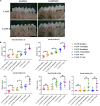F0F1-ATPase Contributes to the Fluoride Tolerance and Cariogenicity of Streptococcus mutans
- PMID: 35173687
- PMCID: PMC8841791
- DOI: 10.3389/fmicb.2021.777504
F0F1-ATPase Contributes to the Fluoride Tolerance and Cariogenicity of Streptococcus mutans
Abstract
The phenotypic traits of Streptococcus mutans, such as fluoride tolerance, are usually associated with genotypic alterations. The aim of this study was to identify adaptive mutations of S. mutans to gradient fluoride concentrations and possible relationships between the mutations and fluoride tolerance. We identified a highly resistant S. mutans strain (FR1000) with a novel single nucleotide polymorphism (SNP, -36G→T) in the promoter region of F0F1-ATPase gene cluster (SMU_1527-SMU_1534) resistant to 1,000 ppm fluoride using the whole-genome Illumina PE250 sequencing. Thus, a -36G→T F0F1-ATPase promoter mutation from the parental strain S. mutans UA159 was constructed and named UA159-T. qRT-PCR showed that the F0F1-ATPase gene expression of both FR1000 and UA159-T was up-regulated, and fluoride tolerance of UA159-T was significantly improved. Complementation of Dicyclohexylcarbodiimide (DCCD), a specific inhibitor of F0F1-ATPase, increased fluoride susceptibility of FR1000 and UA159-T. Intracellular fluoride concentrations of fluoride tolerance strains were higher compared to UA159 strain as demonstrated by 18F analysis. Further validation with rat caries models showed that UA159-T caused more severe caries lesions under fluoride exposure compared with its parental UA159 strain. Overall, the identified -36G→T mutation in the promoter region of F0F1-ATPase gene drastically contributed to the fluoride tolerance and enhanced cariogenicity of S. mutans. These findings provided new insights into the mechanism of microbial fluoride tolerance, and suggested F0F1-ATPase as a potential target for suppressing fluoride resistant strains.
Keywords: Streptococcus mutans; antimicrobials; caries; fluoride(s); genomics.
Copyright © 2022 Li, Qi, Yang, Li, Ren, Li, Zhou, Cai, Xu and Peng.
Conflict of interest statement
The authors declare that the research was conducted in the absence of any commercial or financial relationships that could be construed as a potential conflict of interest.
Figures





Similar articles
-
Genetic Loci Associated With Fluoride Resistance in Streptococcus mutans.Front Microbiol. 2018 Dec 11;9:3093. doi: 10.3389/fmicb.2018.03093. eCollection 2018. Front Microbiol. 2018. PMID: 30619172 Free PMC article.
-
Identification and functional analysis of genome mutations in a fluoride-resistant Streptococcus mutans strain.PLoS One. 2015 Apr 9;10(4):e0122630. doi: 10.1371/journal.pone.0122630. eCollection 2015. PLoS One. 2015. PMID: 25856576 Free PMC article.
-
The Fitness Cost of Fluoride Resistance for Different Streptococcus mutans Strains in Biofilms.Front Microbiol. 2017 Aug 28;8:1630. doi: 10.3389/fmicb.2017.01630. eCollection 2017. Front Microbiol. 2017. PMID: 28894441 Free PMC article.
-
Contribution of chloride channel permease to fluoride resistance in Streptococcus mutans.FEMS Microbiol Lett. 2016 Jun;363(11):fnw101. doi: 10.1093/femsle/fnw101. Epub 2016 Apr 15. FEMS Microbiol Lett. 2016. PMID: 27190286
-
Increased Oxidative Stress Tolerance of a Spontaneously Occurring perR Gene Mutation in Streptococcus mutans UA159.J Bacteriol. 2021 Mar 23;203(8):e00535-20. doi: 10.1128/JB.00535-20. Print 2021 Mar 23. J Bacteriol. 2021. PMID: 33526613 Free PMC article.
Cited by
-
Effect of Arsenic on Fluoride Tolerance in Microbacterium paraoxydans Strain IR-1.Toxics. 2023 Nov 20;11(11):945. doi: 10.3390/toxics11110945. Toxics. 2023. PMID: 37999597 Free PMC article.
-
Editorial: The Pivotal Role of Oral Microbiota Dysbiosis and Microbiota-Host Interactions in Diseases.Front Cell Infect Microbiol. 2022 Jun 14;12:947638. doi: 10.3389/fcimb.2022.947638. eCollection 2022. Front Cell Infect Microbiol. 2022. PMID: 35811683 Free PMC article. No abstract available.
-
The role of plant growth promoting rhizobacteria in strengthening plant resistance to fluoride toxicity: a review.Front Microbiol. 2023 Oct 10;14:1271034. doi: 10.3389/fmicb.2023.1271034. eCollection 2023. Front Microbiol. 2023. PMID: 37901824 Free PMC article. Review.
References
LinkOut - more resources
Full Text Sources

